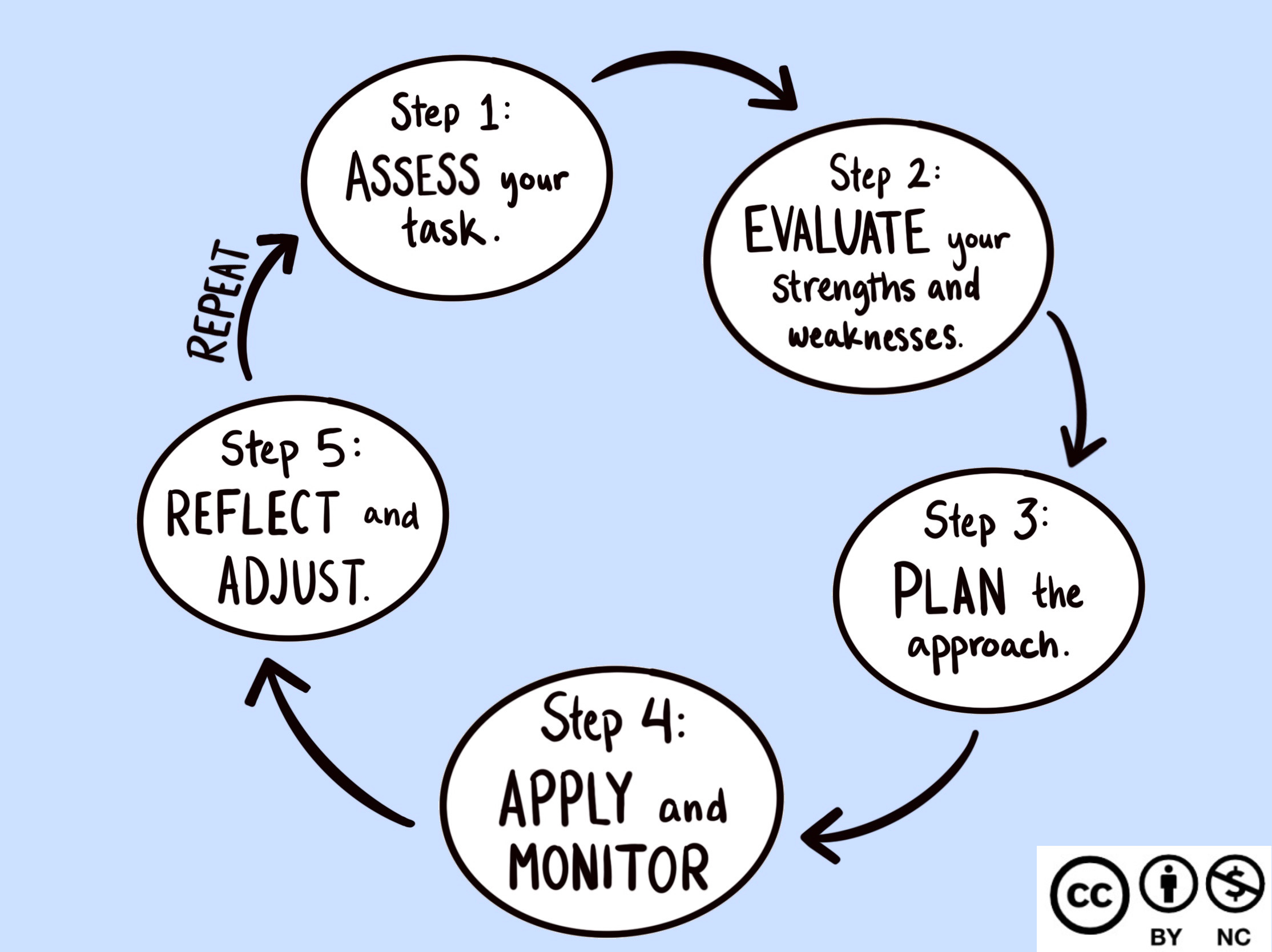Chapter 5 – Metacognition and Metacognitive Strategies
Revisiting the Metacognitive Cycle
Addy Orsi; Faith Adler; Bibi Halima; and Keli Yerian
You made it to the final section of the chapter. Congratulations! Do you feel like you were able to soak it all in? Perhaps you’ll need to reflect on what you’ve read a bit. After all, as you’ve learned, reflecting is a crucial part of the learning process.
While this chapter offers various skills you can build to refine your own learning process, they need to be put into practice for you to actually become proficient in them. It will likely take some trial and error to find what methods work best for you and how you can best use them. This is a natural part of the process.
Putting your goals and strategies into action
Do you remember the phases of metacognition that we discussed earlier? Let’s think through how to incorporate SMART goals and other language learning strategies into the metacognitive cycle.

Your choice of learning strategies will depend on your task or goal. You will probably not choose flashcards as a strategy if your goal is to enjoy listening to songs in your target language. You will also probably not choose practicing with a friend if your goal is to notice familiar grammar patterns in a reading passage.
So, first choose your task, then consider your what strengths and weaknesses you might have related to that task. Doing this will help you plan your approach, which can include making your goal SMART and choosing strategies that can take advantage of your strengths and/or challenge you to improve your weaknesses. For example, maybe you want to improve your fluency in speaking but you are still very nervous about talking to a real person. You could use the strategy of talking to an AI chatbot to build your fluency and confidence on a topic before practicing with another person. Then, all that is left is to try it out, see how it goes, and repeat the cycle! These metacognitive steps might be very intentional at first as you get used to monitoring your own learning, but over time they can become more automatic, just like the procedural skills we discussed in Chapter 2.
Let’s take a look at the case of a past student of LING 144 at the University of Oregon to see how she uses the metacognitive cycle to support her Spanish learning.
Case Study – Meet Jordynn
Jordynn takes Spanish courses at the University of Oregon and studies in her own time. She is also planning to study abroad in Spain during the summer.
Jordynn uses the metacognitive process to minimize the amount of time she spends on a task while maximizing the result. She uses direct strategies such as reading with purpose. The first time she reads something, she reads for the main idea. Then she reads it again to develop a fuller understanding. She also uses indirect strategies like planning out her tasks and giving herself breaks. Additionally, Jordynn is aware of her strengths and weaknesses. She knows she can read Spanish quickly. However, she has more difficulty with writing in Spanish, so it takes her more time. By knowing strengths and weaknesses like these, she is able to plan appropriately and use the most effective strategies.
She says, “I am more confident in my approach to learning when I think about my own process. Because I am able to retroactively evaluate and decide which approaches work best for which tasks, I can comfortably use that approach for the same or similar topics and more easily recall certain strategies when I am learning something new.”
Jordynn is a clear example of a reflective learner. She demonstrates “language awareness”, which is defined as “reflections on one’s knowledge, experiences, emotions and learning” (Haukås, 2018, p. 13).
Making Your Journey Visible
One way to make the important reflective piece more visible to yourself is to keep a record of your long- and short-term goals, your current strategies, and what’s working and what’s not. However you stay organized, this awareness makes it easy to measure whether we are obtaining both short-term and long-term goals. If we’re not, we may be able to identify patterns or specific areas of struggle to inform us on what to work on.
The goal of this chapter isn’t to force you into using any of these strategies, but rather to open your eyes to some of the methods that many people have found helpful in their own journeys. There is an endless list of strategies you could use to refine your learning process, all of which hold their own value, and some of which we will be sharing with you in the following four chapters. We hope that you can take what you’ve learned here and apply it throughout your lifelong learning journey!
References
Haukås, Å. (2018). Metacognition in language learning and teaching: An overview. In A. Haukås, C. Bjørke, & M. Dypedahl (Eds.), Metacognition in language learning and teaching (1st ed., pp. 11-30). Routledge Taylor & Francis.
Media Attribution
The adapted illustration on this page © Addy Orsi is licensed under CC BY-NC 4.0 (Attribution NonCommercial) license.

